
A shrine to the Virgin Mary, or Marian shrine, is a shrine marking an apparition or other miracle ascribed to the Blessed Virgin Mary, or a site on which is centered a historically strong Marian devotion. Such locales are often the destinations of Christian pilgrimages.

Our Lady of China, the Great Mother, also known as Our Lady of Donglü, is a Roman Catholic title of the Blessed Virgin Mary and Child Jesus associated with a purported Marian apparition in Baoding, China in 1900.

The Basilica of the National Shrine of the Blessed Virgin of Ta' Pinu is a Roman Catholic minor basilica and national shrine located some 700 metres (2,300 ft) from the village of Għarb on the island of Gozo, the sister island of Malta.

Our Lady of Aparecida, is a title of the Blessed Virgin Mary associated with the Immaculate Conception.

A canonical coronation is a pious institutional act of the pope, duly expressed in a formal decree of a papal bull, in which the pope bestows the pontifical right to impose an ornamental crown, a diadem or an aureole to an image of Christ, Mary or Joseph that is widely venerated in a particular diocese or locality.

The Sanctuary of Las Lajas is a Roman Catholic minor basilica located within the canyon of the Guáitara River in Ipiales, Nariño Department, Colombia. The Marian shrine is dedicated to the Blessed Virgin Mary as Our Lady of the Rosary.
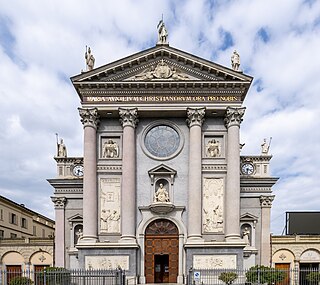
The Basilica of Our Lady Help of Christians is a Pontifical church and Marian shrine in Turin, Italy. The building was originally part of the safehouse for poor boys cared for by Don Bosco, it now contains the remains of Bosco, and six thousand numbered relics of other Catholic saints.
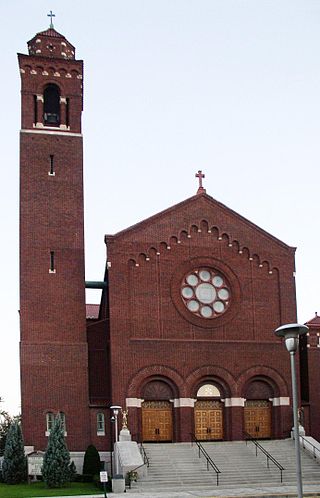
The Basilica and National Shrine of Our Lady of Consolation is a Roman Catholic basilica located in Carey, Ohio in the United States of America and is dedicated to the Blessed Virgin Mary under the title of Our Lady of Consolation. The Marian shrine is administered by the Order of Saint Francis and is designated as National shrine by the Holy Office.
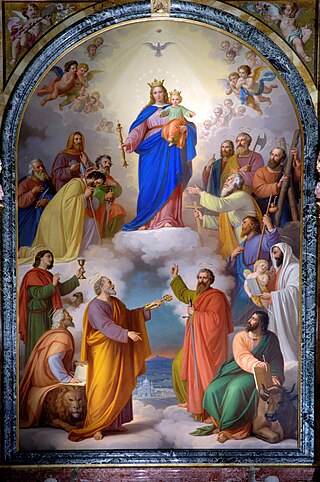
Mary, the Help of Christians, is a Roman Catholic title of the Blessed Virgin Mary, based on a religious devotion now associated with a feast day of the General Roman Calendar on 24 May.

Our Lady of the Fountain in Caravaggio is a purported Marian apparition of the Blessed Virgin Mary at Caravaggio, Lombardy, Italy in 26 May 1432.
Our Lady of Charity is a celebrated Marian title of the Blessed Virgin Mary venerated in many Catholic countries.

The Basílica of the Black Virgin of Monserrat is a historical Roman Catholic shrine built in the town of Hormigueros, Puerto Rico as dedicated to the Blessed Virgin Mary as a Black Madonna under the Marian title of “Virgin of Montserrat”.

The Pontifical Shrine of the Blessed Virgin of the Rosary of Pompei is a Roman Catholic cathedral, Marian pontifical shrine, and Pontifical minor basilica commissioned by Bartolo Longo, located in Pompei, Italy. It is the see of the Territorial Prelature of Pompei.
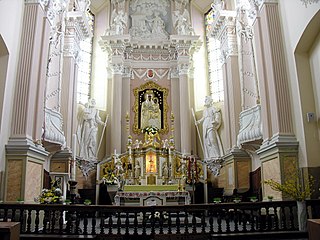
Our Lady of Šiluva is Roman Catholic image of the Blessed Virgin Mary venerated at the Basilica of the Nativity of the Blessed Virgin Mary, Šiluva shrine in Lithuania. The patriotic icon is highly venerated in Lithuania and is often called Lithuania's greatest treasure.
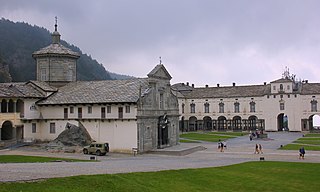
The Sanctuary of Oropa is a group of Roman Catholic buildings and structures in Oropa, frazione of the municipality of Biella, Italy. It is located at a height of 1,159 metres in a small valley of the Alpi Biellesi.

The Bambino Gesu of Arenzano locally known as Il Grande Piccinino is a Roman Catholic image of the Child Jesus venerated by the Genoese faithful.

The Basilica of Our Lady of Consolation of TaribaSpanish: Basílica de Nuestra Señora de la Consolación) is a Roman Catholic Marian shrine and basilica located in the state of Táchira in Venezuela.

The Basilica of the Visitation of Our Lady also called Werl Basilica is a Catholic church located in Werl, Germany which was declared a minor basilica in 1953. It is dedicated to the Visitation of Mary.

Our Lady of Consolation or Mary, Comforter of the Afflicted is a title of the Blessed Virgin Mary venerated in the Catholic Church.
























